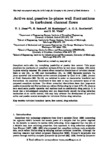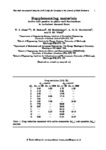Active and passive in-plane wall fluctuations in turbulent channel flows
| dc.contributor.author | Jozsa, Tamas | |
| dc.contributor.author | Balaras, Elias | |
| dc.contributor.author | Kashtalyan, Maria | |
| dc.contributor.author | Borthwick, Alistair | |
| dc.contributor.author | Viola, Ignazio Maria | |
| dc.date.accessioned | 2021-08-22T15:37:47Z | |
| dc.date.available | 2021-08-22T15:37:47Z | |
| dc.date.issued | 2019-05-10 | |
| dc.identifier.issn | 0022-1120 | |
| dc.identifier.issn | 1469-7645 | |
| dc.identifier.uri | http://hdl.handle.net/10026.1/17683 | |
| dc.description.abstract |
<jats:p>Compliant walls offer the tantalising possibility of passive flow control. This paper examines the mechanics of compliant surfaces driven by wall shear stresses, with solely in-plane velocity response. We present direct numerical simulations of turbulent channel flows at low (<jats:inline-formula><jats:alternatives><jats:inline-graphic xmlns:xlink="http://www.w3.org/1999/xlink" mime-subtype="gif" xlink:type="simple" xlink:href="S0022112019001459_inline1" /><jats:tex-math>$Re_{\unicode[STIX]{x1D70F}}\approx 180$</jats:tex-math></jats:alternatives></jats:inline-formula>) and intermediate (<jats:inline-formula><jats:alternatives><jats:inline-graphic xmlns:xlink="http://www.w3.org/1999/xlink" mime-subtype="gif" xlink:type="simple" xlink:href="S0022112019001459_inline2" /><jats:tex-math>$Re_{\unicode[STIX]{x1D70F}}\approx 1000$</jats:tex-math></jats:alternatives></jats:inline-formula>) Reynolds numbers. In-plane spanwise and streamwise active controls proposed by Choi<jats:italic>et al.</jats:italic> (<jats:italic>J. Fluid Mech.</jats:italic>, vol. 262, 1994, pp. 75–110) are revisited in order to characterise beneficial wall fluctuations. An analytical framework is then used to map the parameter space of the proposed compliant surfaces. The direct numerical simulations show that large-scale passive streamwise wall fluctuations can reduce friction drag by at least<jats:inline-formula><jats:alternatives><jats:inline-graphic xmlns:xlink="http://www.w3.org/1999/xlink" mime-subtype="gif" xlink:type="simple" xlink:href="S0022112019001459_inline3" /><jats:tex-math>$3.7\pm 1\,\%$</jats:tex-math></jats:alternatives></jats:inline-formula>, whereas even small-scale passive spanwise wall motions lead to considerable drag penalty. It is found that a well-designed compliant wall can theoretically exploit the drag-reduction mechanism of an active control; this may help advance the development of practical active and passive control strategies for turbulent friction drag reduction.</jats:p> | |
| dc.format.extent | 689-720 | |
| dc.language | en | |
| dc.language.iso | en | |
| dc.publisher | Cambridge University Press (CUP) | |
| dc.title | Active and passive in-plane wall fluctuations in turbulent channel flows | |
| dc.type | journal-article | |
| dc.type | Journal Article | |
| plymouth.volume | 866 | |
| plymouth.publication-status | Published | |
| plymouth.journal | Journal of Fluid Mechanics | |
| dc.identifier.doi | 10.1017/jfm.2019.145 | |
| plymouth.organisational-group | /Plymouth | |
| plymouth.organisational-group | /Plymouth/Faculty of Science and Engineering | |
| plymouth.organisational-group | /Plymouth/Faculty of Science and Engineering/School of Engineering, Computing and Mathematics | |
| plymouth.organisational-group | /Plymouth/Users by role | |
| plymouth.organisational-group | /Plymouth/Users by role/Academics | |
| dc.identifier.eissn | 1469-7645 | |
| dc.rights.embargoperiod | Not known | |
| rioxxterms.versionofrecord | 10.1017/jfm.2019.145 | |
| rioxxterms.licenseref.uri | http://www.rioxx.net/licenses/all-rights-reserved | |
| rioxxterms.type | Journal Article/Review |



